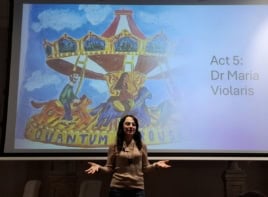A team of Italian and Austrian scientists has shown it is possible to send single photons from a satellite to a receiving station on Earth. The work, carried out using the Matera Laser Ranging Observatory in southern Italy, paves the way for global quantum cryptography and more rigorous tests of quantum mechanics.
Quantum cryptography exploits the laws of quantum mechanics to create keys for encoding and decoding messages. These keys are strings of 1s and 0s, which are represented by the quantum states of individual subatomic particles, such as the polarization of photons. In principle, quantum keys are uncrackable — this is because a measurement of a quantum system in general alters the state of that system. In other words, an eavesdropper situated between a sender and a receiver cannot intercept and identify a key without corrupting it.
Quantum cryptographic systems are already available commercially and have been used, for example, to make bank transfers. Indeed, physicists have shown how to transmit quantum keys over distances of more than 100 km by sending single photons either along optical fibres or via telescopes. Extending this range significantly is difficult, however — in optical fibres photon scattering causes unacceptably high losses, and telescopes are subject to atmospheric turbulence, which can distort a photon beam.
High expectations
Now, Paolo Villoresi of the University of Padova, along with other scientists in Italy and a group lead by Anton Zeilinger at the University of Vienna in Austria, have shown how to overcome these limitations by extending quantum cryptography into space (The New Journal of Physics 10 033038 ).
The Matera Laser Ranging Observatory is usually used to measure variations in the Earth’s gravity and motion, by measuring the time it takes for laser pulses to return to the observatory having been reflected off a passing satellite. Villoresi and colleagues employ the same basic technique but make the beam deliberately weak so less than one photon from each pulse returns to Earth. Transmitting individual photons is crucial for realizing quantum cryptography to prevent an eavesdropper siphoning off excess photons without altering the key.
By bouncing the beam off the Japanese Ajisai satellite, which orbits at an altitude of about 1500 km, the researchers calculate that they receive an average of just 0.4 photons per pulse (after taking into account losses such as the inefficiency of their photon detector). Crucially, by precisely calculating when each pulse is to return to the observatory (accounting for the changing position of the satellite), they are able to show that these detected photons are those transmitted by the telescope and not stray photons from background sources. “Not only have we shown that it is possible to detect single photons from a satellite, we have also demonstrated that we can do this using existing technology,” says Villoresi. “We are very happy about that.”
This work not only opens up the possibility of a network of satellites sending quantum encrypted messages around the world, but it should allow scientists to carry out experiments in fundamental quantum physics. Among these is the Bell inequality, which is a way of testing “non-local” correlations between particles.
The team’s next step is to demonstrate that it can send an actual quantum key from a dedicated satellite. The researchers hope to obtain funding from the Italian Space Agency in order to make an instrument that can transmit polarized single photons, which they can then piggyback onto a suitable satellite. The instrument could be operational by around 2011.



